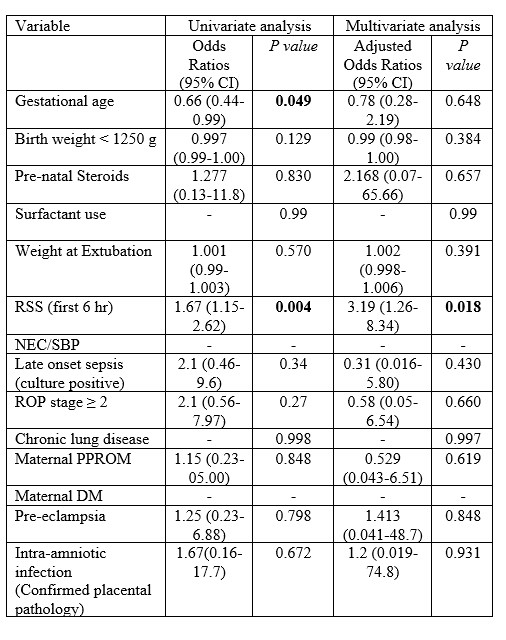Neonatal Respiratory Assessment/Support/Ventilation
Neonatal Respiratory Assessment/Support/Ventilation 5: Surfactant and NIV 2
675 - Performance Evaluation of Neonatal Extubation Readiness Calculator in Preterm Neonates: A Retrospective Analysis in an Inner-City Level 3 NICU
Publication Number: 675.443

Kulsajan S. Bhatia, MBBS
Resident
SUNY Downstate Health Sciences University
Brooklyn, New York, United States
Presenting Author(s)
Background:
Extreme low birth weight infants (ELBW) routinely require prolonged invasive mechanical ventilation, associated with multiple co-morbidities, and required a prolonged hospital stay. Early extubation is critical in decreasing overall morbidity and mortality in ELBW. The routine practice of neonatal extubation is mostly based on clinical judgment.
Objective:
Assess the feasibility of a known extubation readiness estimator (ERE) in ELBW infants, compare it to the success of extubation based on clinical judgment, understand the significance of additional parameters that potentially impact successful extubation and study associated morbidities with failed extubation.
Design/Methods:
We conducted a retrospective chart review for all the intubated preterm neonates with birth weight ≤ 1500 grams and gestational age less than 30 weeks between January 2016-December 2020. Demographic variable including maternal and neonatal characteristics were recorded.
A total of 105 premature neonates were intubated during the study period. 41 intubated neonates were excluded from the study because of death and the non-availability of data. The remaining 64 neonates were assessed for the probability of successful extubation and divided into two groups with extubation readiness probability scores of more than 80% or less than 80%. A probability of more than 80% was considered significant for successful extubation.
Data were analyzed using statistical software, IBM SPSS version 28. The association between risk factors and extubation failure was reported as an odds ratio (OR) and compared using the Chi-square test.
Results:
Fifty-three neonates were extubated successfully, and 11 neonates required reintubation within 5 days of the first attempt. Gestational age and BW were significantly lower in the re-intubation group, with a probability score of less than 80%. The incidence of CLD, ROP stage 2 and higher was significantly higher in the re-intubation group in the ERE score >80% category.
Most babies in the low probability group were extubated to NIMV and remained successfully extubated. Sensitivity, and specificity for the score > 80% were 35.8% and 54.5 %, respectively, which were lower than the model used to develop the estimator (54% and 81%).
Conclusion(s): In our study neonates were successfully extubated based on clinical judgment, even at lower probability scores. Further multicenter prospective study to develop a more robust calculator should be done to avoid complications of prolonged invasive mechanical ventilation in extremely preterm infants.jpg)
.jpg)

